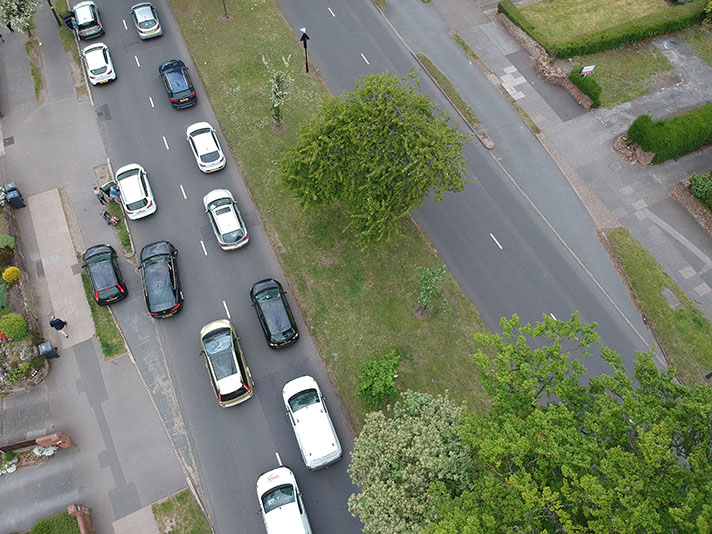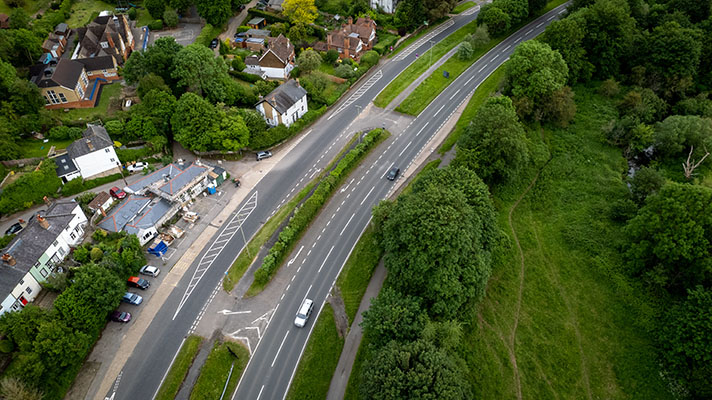“The aim of the Ministry [of Transport] is ultimately to provide, from London to Edinburgh, a road with dual carriageways, cycle tracks and footpaths, and having an overall width of 120 ft,” reported a newspaper in 1939.
Those stretches that were built were swallowed up by frequent remodellings of the road; little trace of them remain.
However, there’s an intriguing, two-mile stretch of what could be a period cycle track between the linear village of Long Bennington and Newark, much of it beside the A1 Great North Road. Just north of Long Bennington, Main Road (the old Great North Road) has remnants of an asphalt track, partly covered in grass, that leads to a marked cycleway beside the modern A1 on the route of the old Great North Road until just south of Newark.
Main Road: https://goo.gl/maps/48FS9b9Wk3nVTXsj8
Cycleway on A1: https://goo.gl/maps/iMaAjDeH7dAPP4xD8
Continues on original route of Great North Road:
https://goo.gl/maps/54xpXm3oWnRvphtM9
There is also a period cycle track on Swanland Road, Potters Bar, which is part
of the former Great North Road, see BARNET BYPASS, A1.
Following the Trunk Roads Act of 1936, after which control of major roads was transferred to central government, the Ministry of Transport paid for the bypasses and road widenings on the A1.
BIGGLESWADE
According to a 1936 newspaper report the [Highways] Committee [of Biggleswade Urban District Council] “considered the suggestion that facilities provided for cycle traffic along the side the Great North Road from the corner of Dunton Lane to Bleak Hall. Recommended that representation be made to the County Council that some arrangements for cycle tracks should made in view the number of people cycling to and from Biggleswade each day and in view of recent accident on that part the road.”
However, the work on this track was not completed, suggests a 1946 news report.
“A cyclists’ track and footpath … was in progress on the Great North Road, south of Biggleswade, when war put an end to all but the most essential work on the County’s highways.”
DONCASTER
“Plans for a proposed new road to by-pass Doncaster from North to South have been deposited by the Minister of Transport with the county and local authorities concerned,” reported a newspaper in June 1938.
“The road, which is intended to divert through traffic from that stretch of the Great North Road running though Bawtry and Doncaster, will be nearly twelve miles long and its cost is expected to be in the region of £1,000,000.
“The by-pass will commence a quarter of a mile south of Bawtry at the junction of the Nottingham road and Great North Road.
“The by-pass will have an effective width of 120 feet. There will be dual carriageways, each 22 feet wide with a central strip of 26 feet which could be narrowed if future traffic made it necessary to widen the carriageway to 30 feet. Two cycle tracks, each nine feet wide in width, will be provided as well as two footpaths of widths varying from four to seven feet.
“Wetherby … will also be equipped with double carriage ways and, ultimately, cycle tracks.”
DARLINGTON
“The Minister of Transport has approved the Darlington by-pass scheme, which was the subject of an inquiry at Darlington last February,” reported a newspaper in February 1939.
“The road will be about seven miles long, leaving the Great North Road near Stapleton. It will be 120 feet wide, with dual carriage ways and cycle tracks.”
GREAT NORTH ROAD BYPASSES
“A hint that in the not very distant future the Great North Road will be a modern dual-track highway with cycle tracks and footpaths, emerged from a speech by a Ministry of Transport official, at the tenth annual dinner of Nottinghamshire Surveyors’ Association, at the Victoria Hotel, Nottingham,” reported the Nottingham Journal in February 1939.
Mr. J. F. A. Baker, engineering inspector, Eastern Division, Ministry of Transport said: “It is proposed to widen same 60 per cent of the existing roads and to substitute new roads for the remaining 40 per cent. This will entail some 106 bypasses, varying in length from 14 miles to one eighth of a mile.
“Thirty-four by-passes have already been submitted for approval, in 22 cases notices have been served on the County Councils, and in seven cases public inquiries have been held. We are entering a further stage. Large schemes are ready for execution and some have already been advertised.”
Baker added: “It will not, I hope, be many years before the Ministry’s representative at your annual dinner will be able tell you all about that modern dual track highway complete with cycle tracks, footpaths and picturesque planting … which the county surveyor will have been occupying some spare time for the benefit of the heavily taxed and long suffering road user.”
LEEMING
“Work gangs have recently begun operations on a £340,000 scheme for widening and by-passing the Great North Road in the North Riding of Yorkshire for a distance of seven miles, starting at the junction with the Ripon and Thirsk road and ending on the south side of Londonderry,” reported the Bradford Observer in March 1939.
“The present single carriageway of 24ft. to 26ft. is to be replaced by a dual carriageway over the whole seven-mile stretch, and this will be supplemented by cycle-tracks on each side of the road.”
BEDFORDSHIRE
“In all [county] trunk road schemes … provision is being made for two 22ft. carriageways, a centre strip 26ft. wide between the carriageways, two cycle tracks 9ft. wide and two footpaths 6ft. wide,” reported the county surveyor to Bedfordshire County Council’s highways committee in June 1939.
“The Great North Road, A1, section from the Herts County boundary to Newspring Farm, length 2.92 miles, has just commenced,” he added.
GRANTHAM
“The section of the Great North-road from Rutland county boundary to the Gem cafe, Colsterworth [consists] of dual carriageways 22ft. in width, two 9ft. cycle tracks, and one 6ft. footpath,” reported the Grantham Journal in 1939.
Works were suspended due to the war. They were resurrected in 1947 with the promise of cycle tracks and footpaths but when the road was built in the 1950s it’s probable that, to save money, these were no longer included.






